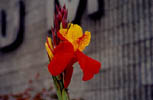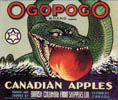 The Ogopogo Country The Ogopogo Country
Vernon
Drawn by the native presence, the first Oblate missionaries ventured into the valley. Father Durieu built a cabin near the junction of Swan Lake and Long Lake Creeks about 1863, joining Luc Girouard, a gold miner and the first white settler in the area, whose property was nearby to the North. The gold miner's camps, in turn, drew cattlemen, anxious to market beef on the hoof. As the cattle ranches flourished, wagon roads replaced the original pack trails. As section of the road from Fort Kamloops, crossing Swan Lake Creek and continuing eastward to the gold mines on Cherry Creek, served as Vernon's first main street. Pleasant Valley Road branched off to the north, skirting the swampy ground below the present cemetery and continuing to the BX Ranch and Spallumcheen.
 Within ten years, the fledging settlement of Priest's Valley (Vernon) boasted a post office, as well as a hotel, general store, and schoolhouse. In 1885 a government agent's office was opened, and Charles Brewer and E.J. Tronson laid out a townsite, christening it Centreville. The Hudson's Bay Company, recognizing the potential of the community, opened a rough wooden store in 1887, the same year the town was renamed Vernon. Transportation links to the outside world became a reality as the CPR main line was completed. By 1890, a charter was granted for the construction of a branch line from Sicamous to Okanagan Landing. In the surrounding district, wheat growing had become an important industry, second only to cattle ranching. Fruit farming was introduced by Lord Aberdeen on the Coldstream Ranch lands, attracting many British families to the area. Within ten years, the fledging settlement of Priest's Valley (Vernon) boasted a post office, as well as a hotel, general store, and schoolhouse. In 1885 a government agent's office was opened, and Charles Brewer and E.J. Tronson laid out a townsite, christening it Centreville. The Hudson's Bay Company, recognizing the potential of the community, opened a rough wooden store in 1887, the same year the town was renamed Vernon. Transportation links to the outside world became a reality as the CPR main line was completed. By 1890, a charter was granted for the construction of a branch line from Sicamous to Okanagan Landing. In the surrounding district, wheat growing had become an important industry, second only to cattle ranching. Fruit farming was introduced by Lord Aberdeen on the Coldstream Ranch lands, attracting many British families to the area.
As the population expanded, construction boomed and new businesses were established. The centre of town began to shift from Coldstream Road (Avenue) to the recently constructed Barnard Avenue (30th Avenue).
The first brick building appeared, wooden sidewalks were built, and the first telephone was installed. Discussions regarding the future of the rapidly growing town culminated in the incorporation of the City of Vernon on December 31st, 1892. Further community development included the opening of the first hospital, the construction of a new brick school, and the installation of street lamps.
In 1903, Vernonites saw the construction of their first city hall, which also served as a fire hall and public reading room. By 1904, Vernon was the largest town in the valley and the first in the Okanagan to have a bank. A school of nursing was established that same year, followed by a telephone exchange housed in Muir's drug store. Shade trees were planted on the main street and another large hotel, the Royal, opened for business. As the end of the decade approached, community services continued to improve. A sewage system was installed and cement sidewalks replaced wooden ones on 30th Avenue. Central School (Beairsto) opened in 1909, as did the new Vernon Jubilee Hospital on Mission Hill. followed by a telephone exchange housed in Muir's drug store. Shade trees were planted on the main street and another large hotel, the Royal, opened for business. As the end of the decade approached, community services continued to improve. A sewage system was installed and cement sidewalks replaced wooden ones on 30th Avenue. Central School (Beairsto) opened in 1909, as did the new Vernon Jubilee Hospital on Mission Hill.
Outside the city limits, the large-scale cattle ranching era was drawing to a close. By the early 1900's the large ranch owners were selling land to developers for subdivision. By 1908, a reported 1,000 fruit trees were planted in the Okanagan Valley and land prices had risen from $1 to $150 an acre. A supply of water was ensured with the construction of the Grey Canal, a 19-mile long irrigation system extending from Lavington to Okanagan Lake.
New subdivisions on East Hill, Mission Hill, and other areas near the city core accommodated the rapid population growth of this period. By this time Vernon was recognized as the economic hub of the Okanagan. This period of growth and development came to an in 1913, when an economic depression slowed the movement of capital for land development.
At the end of World War II a new tide of immigration resulted in a housing shortage, solved in part by the construction of the "100 homes" on the East Hill. The real estate boom of the 1950's was tempered with nostalgia as some historic structures were swept away in the name of modernization. Replacing  outdated civic facilities was the first priority in the 1960's, which led to the construction of the award-winning multi-faceted civic centre. The 1970's saw the decentralization of business as new shopping malls appeared on the edge of the city. outdated civic facilities was the first priority in the 1960's, which led to the construction of the award-winning multi-faceted civic centre. The 1970's saw the decentralization of business as new shopping malls appeared on the edge of the city.
City boundaries continued to expand to include Silver Star Foothills in 1981, Okanagan Landing in 1993, Anderson subdivision in 1994, and the Predator Ridge, O'Keefe Range, and lands north of Silver Star Foothills in 1996. During the 1980's and the early 1990's, both the R.C.M.P. and the museum facilities experienced major expansion and renovations. A new public library was built within the civic complex. Shopping opportunities multiplied with the construction of new shopping complexes and an expansion to the existing regional shopping centre. The late 1990's and early 2000's have seen the construction of a Performing Arts Centre and a multi-purpose facility.
 Vernon's diversified history is reflected in the richness of its built environment. The mosaic of building styles which has evolved over time should be recognized and outstanding examples restored. As the site of the original town, downtown Vernon has retained its role as the centre of commerce and culture for the community. Today, this area contains the greatest concentration of early commercial buildings, as an important and irreplaceable statement of the city's evolution. The downtown core heritage resource is protected by design guidelines that serve to protect heritage buildings and establish parameters for new construction. A mural project, which illustrates many historical features, has become a popular asset for downtown Vernon. In addition, the older residential neighbourhood of the East Hill contains the greatest density of heritage homes in the Vernon area, further enhanced by a significant number of mature trees. Vernon's diversified history is reflected in the richness of its built environment. The mosaic of building styles which has evolved over time should be recognized and outstanding examples restored. As the site of the original town, downtown Vernon has retained its role as the centre of commerce and culture for the community. Today, this area contains the greatest concentration of early commercial buildings, as an important and irreplaceable statement of the city's evolution. The downtown core heritage resource is protected by design guidelines that serve to protect heritage buildings and establish parameters for new construction. A mural project, which illustrates many historical features, has become a popular asset for downtown Vernon. In addition, the older residential neighbourhood of the East Hill contains the greatest density of heritage homes in the Vernon area, further enhanced by a significant number of mature trees.
 OGOPOGO (from Vernon's centennial celebration) OGOPOGO (from Vernon's centennial celebration)
The origin of the application of the name "Ogopogo" to the unidentified creature which is said to have been seen in Okanagan Lake, originated in Vernon.
After World War One, there was an organization of amateur entertainers in Vernon, known as the "Kalamalka Players," who raised several thousand dollars for charitable purposes. One of this aggregation, the late W. H. Brimblecombe, sang the Ogopogo song, originally created by one- Davy Burnaby of the "Co-Optimists," an English company which held a wide reputation in the musical and light comedy world.
On August 23,1926, a luncheon for the Vancouver Board of Trade was hosted by the Vernon Rotary Club and Vernon Board of Trade in the Kalamalka Hotel, when Mr. Brimblecombe sang the Ogopogo song. At that time there was considerable talk about a mysterious creature in Okanagan Lake. The name and tune of the song and rumors of the monster caught on, and the guests left Vernon to spread the fame of Ogopogo far and wide.
About that time the late J. L. Logie of Okanagan Centre is alleged to have seen Ogopogo near Peachland, rushing at a tremendous speed. Mr. Logie chased it for some distance along the road, which, at that place, follows the lake shore.
The report of this chase with an automobile, after making the rounds of B.C. newspapers, eventually found its way into the columns of "Punch."
After that no one could say the Ogopogo of the Okanagan Lake was not famous. He is still leading people a merry dance. Dozens of citizens, and residents of various Okanagan Lake points, declare they have seen the monster.
Through the years, Ogopogo has become a tradition, firmly established in the history of the communities which have developed around the lake.
The chorus of Davy Burnaby's song runs: "I'm looking for the Ogopogo. The funny little Ogopogo, His mother was an earwig, his father was a snail. I'm going to put a little bit of salt upon his tail. I want to find the Ogopogo while he's playing his old banjo. The Lord Mayor of London Wants to Put him in the Lord Mayor's Show."
|


